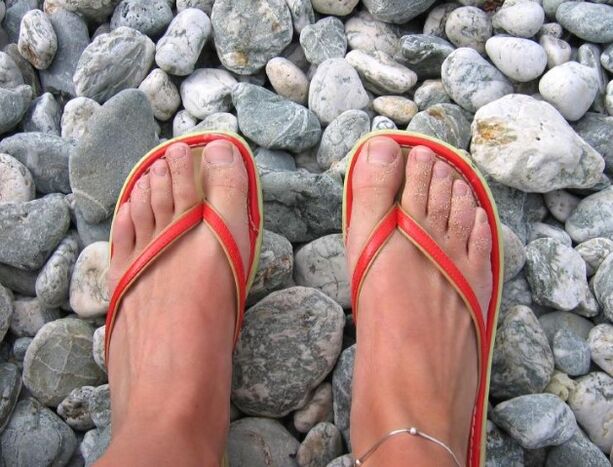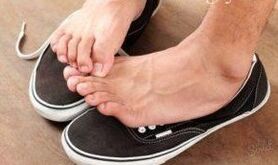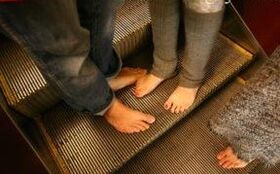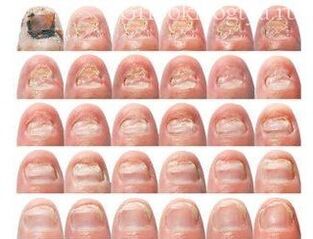The nail fungus is a quite dangerous phenomenon that can progress, destroying all the nail plaque. In the early stages of development, the fungus can be invisible to the eye, however, its negative effect on the structure of the nail plate intensifies every day. How to identify the fungus of the nails yourself and how to treat it, given the stage of the disease, we will analyze more.

There are a number of signs that help determine the presence of fungal lesions of the nail plate:
- The loosen of the nail: you can verify when cutting the edge of the nail. If in the process the nail falls apart, not cut, this is the first symptom of the presence of a fungus and a clear occasion to see a doctor.
- The thickening of the nail plate, mainly on the border-hydrakeratosis (compaction) occurs due to the harmful effects of fungi that can interrupt the integrity of nail fibers, so the latter changes qualitatively and quantitatively.
- Excol of the nail and its cut under the skin: such a phenomenon can cause not only to wear tight shoes, but also fungal lesions that modify the nail plate, providing the incorrect location.
- The change in the color of the nail (from pale to brown yellow) occurs as a result of the destruction of the active components of the nail plate and the folding of protein cells during destruction.
- The presence of the white plaque: the fungal spores penetrate deeply into the root of the nail, and also reach the surface, which is dangerous for the extensive infection of all fingers of the feet.
The first signs that the nail has lost its health and has problems caused by the active activity of fungi, are:
- loss of brightness and surface brightness;
- light yellowish of the nail;
- Extensive items of all your foot, the appearance of red points full of transparent fluid;
- Unpleasant leg smell, especially after abundant sweating;
- Crossing the skin on heels and soles, extensive redness.
These symptoms indicate several leg problems, so it is better not to neglect a doctor's consultation. Early diagnosis greatly facilitates the treatment process, guaranteeing complete recovery.

Healthy legs on the legs: norm and deviation
To exclude or identify the presence of fungal diseases, you must examine your own legs, fingers and nails. The following indicators must be maintained:
- The foot of the legs is smooth, without calluses, corns and stamps.
- The skin of the legs is uniform, without cracks and spots.
- There is no redness and itching, especially between the fingers.
- The nail plate is flat, simple, transparent.
- The bed of the nail, the surface with the brightness is very visible.
If there are deviations from established standards, and the legs have a smell of unpleasant mince, a doctor's consultation and a survey for the presence of the pathogen.
Risk factors for the development of leg fungi
Fungi infection can occur in absolutely anywhere, including home shoes. For this to happen enough to have:
- weak immunity that cannot restrict active reproduction of fungi;
- Increased leg sweating, due to incorrectly selected and low quality shoes;
- the presence of cuts in the nail area with fruitless cut of the nail or cuticle;
- insufficient foot hygiene, as well as shoes;
- Frequent visit to public places where there is a high risk of infection: city baths, saunas, solarium, pool, local beach;
- Excessive use of cosmetics (varnishes, nail extension, refreshing sprayers and leg gels), which leads to the death of local immunity.
Separate fungal types have a different latent period during which the disease does not manifest.
It can be infected with a fungus in two ways:
- Contact: Through the direct contact of a sick person to a healthy: personal hygiene articles, public places, with shoes from another person.
- Contact: The infection occurs due to the active development of the fungi in each person's body. In certain situations (for example, a strong decrease in immunity), its number increases and cannot be fully controlled by the body independently.
Very often, people in the following categories are subject to fungal lesions:
- Children with a thinner layer of skin;
- people suffering from HIV infection;
- with greater sweating feet;
- The presence of chronic diseases that inhibit the immune system.

If the previous indicators exist, the condition of the nails on the legs is required and stop as a whole to be carefully monitored, paying due attention to hygiene.
Differentiation of a fungal nail disease
In medicine, the concept of "fungal damage to the nail" is collective, since the fungi of various types can act as a pathogen. Very often, such fungi are found on the nails of the legs as:
- Dermatophytes: a group of fungi that manifest in the form of yellow spots or white vertical stripes. The infected nail gradually loses its resistance and shape, after which the cavity becomes lifeless and is easily eliminated from the nail bed.
- Yeast lesions: They arise as a result of the active activity of the fungi of the genus Candida. The nail itself is thinner, and the periolino roller blushes and swells. It can be manifested as an independent disease with frequent prolonged colds and weakened immunity.
- The molds: they are mainly on the surface of the nail, changing their color to a greenish, brownish or whitish dye.
It is impossible to determine the causal agent of a fungal disease on their own, since the same fungi, when exposed to several aggregate factors, can manifest differently. Consequently, it is impossible to start treatment, since each type of fungi has its own antifungal medications that negatively affect the life of pathogens. Therefore, as the slightest deviations from the standard diagnose, you must consult a doctor, as well as test for a fungus.
Stages of fungal legs to the legs
The process from the moment of infection to the complete destruction of the nail plate is called the stages of the disease course. Select them 5:
- Infection: The fungus enters the surface of the nail, sinking through the cuticle in the nail bed.
- The incubation period (from 3 days to 5 months): the activity of the fungi is minimal, but it intensifies with the speed of lightning when all conditions are created for this: immunity weakens, there is a humid warm means, there is no adequate hygiene. Externally, the incubation period is not manifested in any way.
- The initial stage: the number of fungi is so great that it can have a negative effect on the viability of the nail. The edges of the nail plate gradually become yellow from the edge to the bed of the nail. The nail acquires a matt tone, a healthy pink color disappears, the brightness disappears from the surface. In this case, the dry skin of the fingers is observed.
- The stage of the active course: the fungal population reaches the maximum, which allows it to infect other nail plates, having received disputes through contact. Hyperkeratosis is improved: greater production of keratin fibers, under the influence of fungal activity. In this case, the nail is compact, remarkably bulky on the surface of the finger.
- The last stage is determined by the murder of the nail plate as a result of the lesion not only of the nail, but also of the nearby soft tissues. The entire surface of the nail has a yellow or brown tone, there is laziness in the cut, which is accompanied by painful sensations.
With a large -scale infection, local symptoms can also join:
- disbiosis in the form of stool disorder;
- increase in body temperature;
- leg pain, intensifying during movement;
- Confession connection.
All previous manifestations help exclusively determine the stage of the course of onychomycosis. To identify the pathogen, you must take a special analysis that indicates the exact genre and the type of fungi that caused onychomycosis.
How and what to treat

You must understand that the key to successful treatment is a correct diagnosis, which is impossible to do at home at home. Only a doctor, based on the results of the analysis, can identify a genre of fungi, as well as choose the appropriate treatment.
For many, it is still a mystery why, the antifungal medicine bought in a pharmacy does not help. There are many reasons and explanations for this. First, initially the antifungal drug is selected based on the generator. Second, the treatment of the fungus is a complex event that consists of:
- Local therapy: applying antimicotic drugs to the nail surface.
- Oral antimicotic tablets that can suppress fungal development and reduce their number from the inside.
- Immunostimulant drugs that "force" the body to produce a sufficient number of immune cars that fight independently in fungi.
- Football compliance: The legs are washed 2-3 times a day, with cold water and soap, after which they dry with a towel. The nail is cut every 3-5 days.
- Using genuine leather shoes, as well as cotton linen.
Having excluded at least one of these 5 points, the recovery process will last for many months, or will not even succeed. Only an integral treatment will allow you to completely get rid of the fungus, as well as exclude the risks of relapse manifestation.
Recipes for traditional medicine, which are so difficult to cure nail fungus, in most cases are ineffective. The result will appear only when the above recommendations will be added to combat fungal nail lesions.
Therefore, it is not difficult to determine the presence of a fungus in the nails of the legs. It is sufficient to make an inspection of the nail plate and all fingers in general, comparing them with images that indicate the presence of a fungus. The treatment is considered effective and correct only when carried out under the control of specialists. Auto -medical can cause many negative health consequences, as well as complicate an additional treatment of the disease.
















